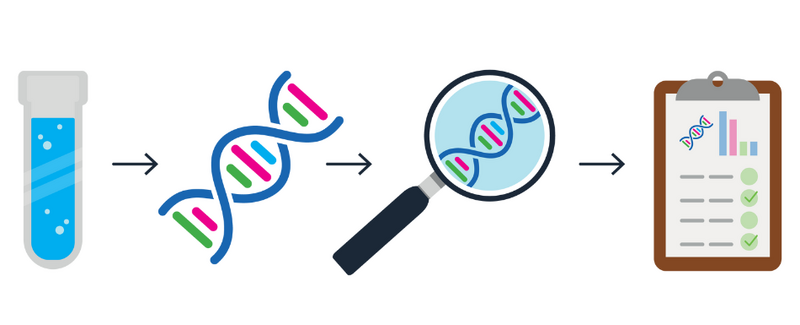Genomics 101: What does no primary findings mean?
By Florence Cornish onIn this series, ‘Genomics 101’, we go back to basics and explore some of the most important topics in genomics. In this blog, we explain what is meant by ‘no primary findings.’
First things first, what do genomic tests look for?
Our DNA is made up of a long sequence of letters that act like instructions for our bodies.
Genomic testing analyses these letters, to see if there are any patterns or changes that might be affecting our health.
If we imagine our DNA as a book full of recipes, every recipe tells our bodies how to make proteins we need to survive. Sometimes there might be a typo in the recipe, like a missing ingredient or mixing up the steps. This could result in a health problem, just like how a changed recipe can affect the final dish.
Why might someone get a genomic test?
In total, there are around 3 billion DNA letters in the human genome. Lots of these letters will be different from person to person, and it's this variation that makes us all unique.
Genomic testing is designed to identify which of these changes are harmless, and which ones might be having an impact on our health or causing a particular condition.
A person might do a genomic test if they have a suspected genetic condition, and the medical team wants to identify the exact genetic cause.
In other cases, someone might have been diagnosed with cancer, and genomic testing can help provide more information about the cancer type and how it could be treated.
In the NHS, people with suspected rare conditions and cancers could be offered whole genome sequencing.
So, what do we mean by primary findings?
If a genomic test results in primary findings, this means that scientists have identified genetic changes linked to the patient's condition.
At Genomics England, we have special pipelines, or processes, which automatically prioritise genetic changes that are likely to be relevant to the patient's condition.
Using this data, NHS clinical scientists will then determine whether any of these genetic changes are linked to the patient's condition, which would explain why certain health problems are happening.

What do we mean by no primary findings?
Not all genomic tests will result in primary findings or a diagnosis.
When no primary findings are found, this means that no genetic changes have been identified as relevant to the patient’s condition.
In the NHS, patients or research participants may consent to have their data stored in the National Genomic Research Library. This allows their data to be looked at again in the future, either in light of new evidence or once our knowledge of genetics has improved.
One of the ways Genomics England is helping to do this is via the Diagnostic Discovery pathway. This process allows scientists and researchers to share newly identified genetic changes with NHS clinical teams, potentially resulting in new diagnoses for those who have had whole genome sequencing in the past.
What do we mean by additional findings?
Additional findings, sometimes referred to as secondary findings, are findings not related to the conditions in which the patient was recruited for.
For example, if a patient was recruited for one type of cancer, but their genomic testing revealed genetic changes that are linked to a different condition.
Secondary findings were explored in the 100,000 Genomes Project, a landmark study that sequenced over 100,000 genomes from participants affected by rare conditions or cancer. However, they are not currently explored in the Genomic Medicine Service.
And finally...
Prefer to listen? Check out our Genomics 101 Podcast: What does ‘no primary findings mean?’
Or, you can also read our other Genomics 101 blogs.

